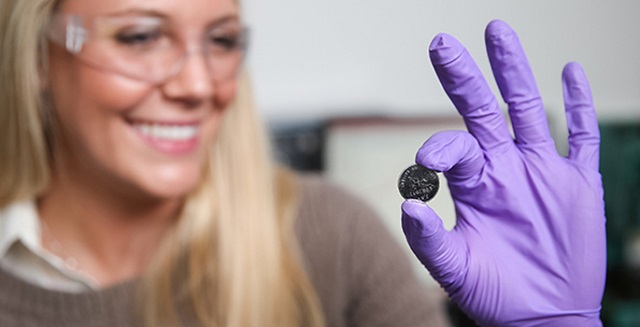It has shown that the addition of fools gold quantum dots to lithium batteries facilitates ultrafast charging that works over multiple charge cycles. Previous attempts to achieve this gave batteries that only performed well over one or two cycles.
 Vanderbilt graduate student Anna Douglas holding one of the batteries that she has modified by adding millions of quantum dots made from iron pyrite, fool's gold. Credit:John Russell, Vanderbilt University
Vanderbilt graduate student Anna Douglas holding one of the batteries that she has modified by adding millions of quantum dots made from iron pyrite, fool's gold. Credit:John Russell, Vanderbilt University
THe addition of quantum dots to a smartphone battery have been shown to enable it to charge within 30 seconds. However, until now this behaviour has only been sustainable for a small number of recharge cycles.
In this study, the team found that this problem could be addressed by using iron pyrite, or fool’s gold, to produce the quantum dots. The fools gold batteries could charge rapidly and also last for more cycles.
Iron pyrite is extremely abundant and is obtained as a byproduct of coal production. It is very cheap, and is used in disposible lithium batteries. However, the team faced significant difficulty when they tried to produce the nanoparticles to enhance battery performance.
Researchers have demonstrated that nanoscale materials can significantly improve batteries, but there is a limit.
When the particles get very small, generally meaning below 10 nanometers (40 to 50 atoms wide), the nanoparticles begin to chemically react with the electrolytes and so can only charge and discharge a few times. So this size regime is forbidden in commercial lithium-ion batteries.
Prof. Cary Pint - Vanderbilt University
The group added millions of iron pyrite quantum dots of various sizes to commonly used lithium button batteries. The team observed that nanocrystals of approximately 4.5 nm provided the best result for enhancing the rate and cycling capabilities of the lithium batteries.
When storing energy, iron pyrite changes into a different compound consisting of lithium-sulfur and iron.
This is a different mechanism from how commercial lithium-ion batteries store charge, where lithium inserts into a material during charging and is extracted while discharging – all the while leaving the material that stores the lithium mostly unchanged
Anna Douglas - Vanderbilt University
You can think of it like vanilla cake. Storing lithium or sodium in conventional battery materials is like pushing chocolate chips into the cake and then pulling the intact chips back out.
With the interesting materials we’re studying, you put chocolate chips into vanilla cake and it changes into a chocolate cake with vanilla chips.
Prof. Cary Pint - Vanderbilt University
Quantum dots must be used as during each charge and discharge cycle iron atoms need to diffuse into and out of the fools gold. As iron diffuses slowly the size of each fools gold particle must be smaller than the iron diffusion length, this is only possible if the nanoparticles are ultrasmall.
The team observed that the small dimensions of the ultra-small nanoparticles enabled iron to move to the surface when the lithium reacted with the iron pyrite’s sulfurs. However, when the particles were larger, iron was not able to move through the iron pyrite materials and this restricted the storage capability of the material.
Gaining insights into chemical storage mechanisms and their dependency on nanoscale dimensions is important for enhancing the performance of batteries so they can be used in electric vehicles.
The batteries of tomorrow that can charge in seconds and discharge in days will not just use nanotechnology, they will benefit from the development of new tools that will allow us to design nanostructures that can stand up to tens of thousands of cycles and possess energy storage capacities rivaling that of gasoline.
Our research is a major step in this direction.
Prof. Cary Pint - Vanderbilt University
The study paper has been published in the journal, ACS Nano.